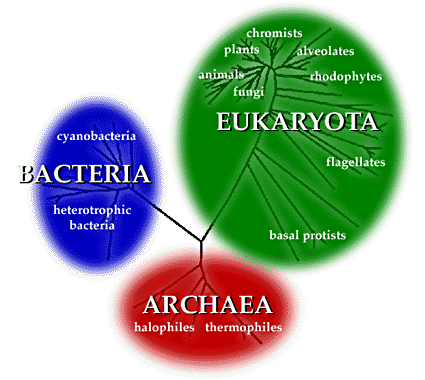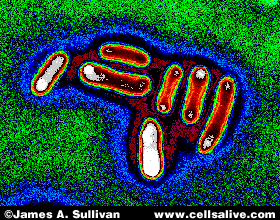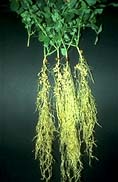Back to: Biology 112 Syllabus
Back to: Biology 112: Evolution and EcologyHome Page
Back to: Kenyon College Biology Department
Week 5: Revolutions in biological diversity: metabolic diversity
Assigned reading: Chapters 27 in text
Quiz this week? yes, Quiz 3 on Chapters 27
Study help:
Bacteria and Archaea: The Prokaryotic Domains
There are two themes to this week's topics:
--these are often considered the "invisible domains", but are they?
--these domains represent the first adaptive radiations
How are prokaryotes organized?
How do bacteria respond to their environments?
What mechanisms promote such high metabolic diversity?
What are the ecological roles of prokaryotes?
Why, and when, did some heterotrophic protists become multicellular?
How did different evolutionary paths solve the problems associated with multicellularity?
How are prokaryotes organized?
Because prokaryotes are small, the methods of classification used for larger
organisms are difficult to apply or unworkable for the bacteria and archaea.
Scientists use other information, like biochemical patterns, modes of moving,
and, increasingly, patterns of sequences of base pairs in ribosomal RNA. Recall
that rRNA is ancient, that all living organisms have rRNA, that it works the
same way in all organisms, and that this molecule evolves slowly.
Take a look at the diagram at right. Note that this phylogeny is not drawn in the typical cladogram fashion. Can you detect where the ancient, common ancestor would be for these three domains? Your text provides another phylogeny, reproduced by your instructor, below:
The
image above comes from the UC Berkeley
Museum of Paleontology. Go see it on line!

In the phylogeny at left you can see that the authors suggest that the Eukarya
are more closely related to the Archaea than they are to the Bacteria.
A little about Bacteria:
(from the UC Berkeley pages)
 A
more or less typical bacterium, shown at right, is comparatively much simpler
than a typical eukaryotic cell. View the transmission electron micrograph of
a typical bacterium, E. coli, below and compare it with the diagram at
right, which comes from the
UC Berkeley pages.
A
more or less typical bacterium, shown at right, is comparatively much simpler
than a typical eukaryotic cell. View the transmission electron micrograph of
a typical bacterium, E. coli, below and compare it with the diagram at
right, which comes from the
UC Berkeley pages.
Bacteria lack the membrane-bound nuclei of eukaryotes; their DNA forms a tangle
known as a nucleoid, but there is no membrane around the nucleoid, and
the DNA is not bound to proteins as it is in eukaryotes. Whereas eukaryotic
DNA is organized into linear pieces, the chromosomes, bacterial DNA forms loops.
Bacteria contain plasmids, or small loops of DNA, that can be transmitted
from one cell to another, either in the course of sex (yes, bacteria have sex)
or by viruses. This ability to trade genes with all comers makes bacteria amazingly
adaptable; beneficial genes, like those for antibiotic resistance, may be spread
very rapidly through bacterial populations. It also makes bacteria favorites
of molecular biologists and genetic engineers; new genes can be inserted into
bacteria with ease.
 Bacteria do not contain membrane-bound organelles such as mitochondria
or chloroplasts, as eukaryotes do. However, photosynthetic bacteria, such as
cyanobacteria, may be filled with tightly packed folds of their outer membrane.
The effect of these membranes is to increase the potential surface area on which
photosynthesis can take place. The cell membrane is surrounded by a cell wall
in all bacteria except one group, the Mollicutes, which includes pathogens such
as the mycoplasmas. The composition of the cell wall varies among species and
is an important character for identifying and classifying bacteria. In this
diagram, the bacterium has a fairly thick cell wall made of peptidoglycan
(carbohydrate polymers cross-linked by proteins); such bacteria retain a purple
color when stained with a dye known as crystal violet, and are known as Gram-positive
(after the Danish bacteriologist who developed this staining procedure). Other
bacteria have double cell walls, with a thin inner wall of peptidoglycan and
an outer wall of carbohydrates, proteins, and lipids. Such bacteria do not stain
purple with crystal violet and are known as Gram-negative.
And there are lots and lots of shapes
to see, not only of individuals but colonies as well..
Bacteria do not contain membrane-bound organelles such as mitochondria
or chloroplasts, as eukaryotes do. However, photosynthetic bacteria, such as
cyanobacteria, may be filled with tightly packed folds of their outer membrane.
The effect of these membranes is to increase the potential surface area on which
photosynthesis can take place. The cell membrane is surrounded by a cell wall
in all bacteria except one group, the Mollicutes, which includes pathogens such
as the mycoplasmas. The composition of the cell wall varies among species and
is an important character for identifying and classifying bacteria. In this
diagram, the bacterium has a fairly thick cell wall made of peptidoglycan
(carbohydrate polymers cross-linked by proteins); such bacteria retain a purple
color when stained with a dye known as crystal violet, and are known as Gram-positive
(after the Danish bacteriologist who developed this staining procedure). Other
bacteria have double cell walls, with a thin inner wall of peptidoglycan and
an outer wall of carbohydrates, proteins, and lipids. Such bacteria do not stain
purple with crystal violet and are known as Gram-negative.
And there are lots and lots of shapes
to see, not only of individuals but colonies as well..
Bacteria
grow in a wide variety of habitats and conditions.
Bacteria are so widespread that it is possible only to make the most general
statements about their life history and ecology. They may be found on the tops
of mountains, the bottom of the deepest oceans, in the guts of animals, and
even in the frozen rocks and ice of Antarctica. One feature that has enabled
them to spread so far, and last so long is their ability to go dormant for an
extended period. Some are thermophillic,
thriving in temperatures as high as 110 degrees Celsius! Other
Bacteria
have a wide range of environmental and nutritive requirements.
Most bacteria may be placed into one of three groups based on their response
to gaseous oxygen. Aerobic bacteria thrive in the presence of oxygen
and require it for their continued growth and existence. Other bacteria are
anaerobic, and cannot tolerate gaseous oxygen, such as those bacteria
which live in deep underwater sediments, or those which cause bacterial food
poisoning. The third group are the facultative anaerobes, which prefer
growing in the presence of oxygen, but can continue to grow without it.
Bacteria may also be classified both by the mode by which they obtain their
energy. Classified by the source of their energy, bacteria fall into two categories:
heterotrophs and autotrophs. Heterotrophs derive energy from breaking
down complex organic compounds that they must take in from the environment --
this includes saprobic bacteria found in decaying material, as well as those
that rely on fermentation or respiration.
The other group, the autotrophs, fix carbon dioxide to make their own
food source; this may be fueled by light energy (photoautotrophic), or by oxidation
of nitrogen, sulfur, or other elements (chemoautotrophic). While chemoautotrophs
are uncommon, photoautotrophs are common and quite diverse. They include the
cyanobacteria,
green sulfur bacteria, purple sulfur bacteria, and purple nonsulfur bacteria.
The sulfur bacteria are particularly  interesting, since they use hydrogen
sulfide as hydrogen donor, instead of water like most other photosynthetic organisms,
including cyanobacteria.
interesting, since they use hydrogen
sulfide as hydrogen donor, instead of water like most other photosynthetic organisms,
including cyanobacteria.
Click on the image at left to learn about how not to
walk on live bacteria!
This page is a very nice intro to cyanobacteria, and its parent site, The
Microbial World,is really good too!.
Bacteria
play important roles in the global ecosystem. The ecosystem,
both on land and in the water, depends heavily upon the activity of bacteria.
The cycling of nutrients such as carbon, nitrogen, and sulfur is completed by
their ceaseless labor. Organic carbon, in the form of dead and rotting organisms,
would quickly deplete the carbon dioxide in the atmosphere if not for the activity
of decomposers. This may not sound too bad to you, but realize that without
carbon dioxide, there would be no photosynthesis in plants, and no food. When
organisms die, the carbon contained in their tissues becomes unavailable for
most other living things.
Decomposition (in the link, look for the section about composting...)
is the breakdown of these organisms, and the release of nutrients back into
the environment, and is one of the most important roles of the bacteria. The
cycling of nitrogen is another important activity of bacteria. Plants rely on
nitrogen from the soil for their health and growth, and cannot acquire it from
the gaseous nitrogen in the atmosphere. The primary way in which nitrogen becomes
available to them is through nitrogen
fixation by bacteria such as Rhizobium, and by cyanobacteria
such as Anabaena, Nostoc, and Spirulina. These bacteria convert gaseous
nitrogen into nitrates or nitrites as part of their metabolism, and the resulting
products are released into the environment. Some plants, such as liverworts,
cycads, and legumes have taken special advantage of this process by modifying
their structure to house the bacteria in their own tissues. Other denitrifying bacteria metabolize in the reverse
direction, turning nitrates into nitrogen gas or nitrous oxide. When colonies
of these bacteria occur on croplands, they may deplete the soil nutrients, and
make it difficult for crops to grow. All part of the nitrogen
cycle!
in their own tissues. Other denitrifying bacteria metabolize in the reverse
direction, turning nitrates into nitrogen gas or nitrous oxide. When colonies
of these bacteria occur on croplands, they may deplete the soil nutrients, and
make it difficult for crops to grow. All part of the nitrogen
cycle!
The photo at left shows root nodules on the roots of a pea plant; these nodules contain the bacterium Rhizobium, which fixes atmospheric nitrogen gas into ammonium, a form of N that plants can readily utilize. Click to enlarge, and on this link to see the great site from which the photo comes (D. Dalton, Biology Dept., Reed College.)
Cool legumes! Or, should that be "cool beans"?
Want to create a nifty bacterial microcosm?
Try this: Winogradsky column: perpetual life in a tube
And now a little about Archaea:
(from The
Microbial World and other pages)
The archaea are a fascinating group of organisms. Although they look like bacteria,
and have simple cells with a  prokaryotic structure, they have biochemical
and genetic features quite different from those of bacteria. For example:
prokaryotic structure, they have biochemical
and genetic features quite different from those of bacteria. For example:
The images in this section are from K.O.Stetter & R.Rachel, Univ.Regensburg.
 In terms of physiology and
behavior, the archaea fall into three major types. Extreme thermophiles,
growing at temperatures of 80°C or more. These organisms typically occur
near geothermal vents (see Thermophilic
microorganisms).
In terms of physiology and
behavior, the archaea fall into three major types. Extreme thermophiles,
growing at temperatures of 80°C or more. These organisms typically occur
near geothermal vents (see Thermophilic
microorganisms). Halophiles, growing
in extremely saline environments - they require solutions of at least 10% sodium
chloride for their growth. Methanogens (methane-generators), which grow
in anaerobic conditions, gaining energy by oxidizing hydrogen. For this, they
use CO2 as the oxidant, reducing it to methane (CH4) in the process. The methanogens
use simple organic acids such as acetate for synthesis of their cellular components.
These organic acids are produced by other anaerobic bacteria as the end-products
of growth on cellulose and other polymers. So, the methanogens are abundant
wherever organic matter is present in anaerobic conditions - land-fill sites,
the rumen of cows, etc. The growth conditions for the archaea are thought to
resemble those that existed in the early stages of the earth's history. Thus,
these organisms were termed archaebacteria (ancient bacteria) when they were
first discovered. But we should not assume that they were necessarily the first
microorganisms.
Some of the phylogeny of the Archaeans has been worked out. This phylogeny comes from the Penn State Dept. of Biochemistry and Molecular Biology:
Great source for links to Archaeans:
On-line resources not provided above:
For a good comparison of Bacteria, Archaea, and Eukaryotic structures and functions,
see:
Organization
and Structure of Microorganisms
Cells Alive! Great photos, information!
Deep Sea Vents and extremophiles
Key concepts and definitions to know:
You've made it this far. You've earned a link to The Far Side...